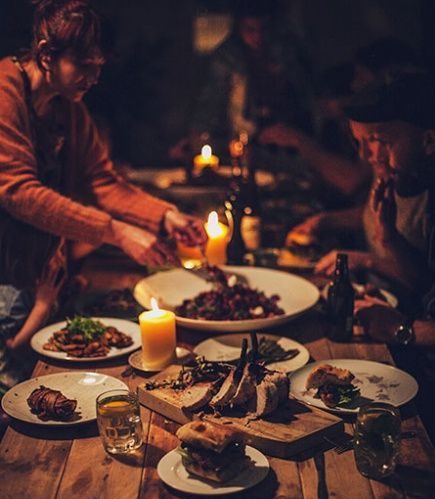How is it that food alters or influences our behaviors— positively, without guilt? For this project, I look to one of the happiest countries in the world, Denmark. The Danes are known for partaking in the Swedish lifestyle, Hygge [“hoo-ga”]—the quality of being cozy. Mainstream media has commodified this concept of being cozy, therefore through this lens, hygge becomes the quantity of being cozy. The practice evokes an abundance of life, meaning true hygge is reflective of self and those who one shares these moments with. The common objects associated with hygge (e.g. candles, blankets, etc.) will adorn the surface of a space, while objects/food that are personal to an individual become tangible representations of memories. This is a celebration of life, therefore when you invite people into this space, you invite fond memories of childhood and embark on memories in the making.
Life is a fundamental piece of hygge and is what shapes the experience. When we are forced into circumstances that isolate us from this habitual closeness, what then becomes of hygge? Life is complex, thus hygge must be, too. Besides yourself, family, and friends, there are many elements that hygge is comprise of; food and drink being just one category. They provide us with opportunities to remain both virtually social and socially distanced in-person. A ‘Do it yourself’ (DIY) project is an excellent example of hyggelig (hygee-like–used as an adverb ex.”It was a hyggelig night.” ), e.g. making sourdough bread. In this case, the longer the cooking process, the more hyggelig it is. The lack of exposure to human life throughout COVID-19 has granted time for us seek other forms of life, perhaps by personifying the inanimate, like sourdough. The step-by-step instructions allow our brain to slow down, mindful of the life put into the bread; kneading the dough, allowing it to rest, and witnessing the rise of its breath in one stretched inhale–you exhale.
We are more inclined to be emotionally attached to objects or food that remind of people or places that we yearn for. People or places that are familiar, safe. People or places that make us feel needed, necessary. Studies suggest that the sentimental nature of foods tied to happy memories temporarily provide comfort. This is just what eating the hygge way does. Moreover, taking periodic breaks from the demands you may experience on a day-to-day basis is encouraged by the Danes. Often times these breaks will consist of savoring an edible treat, and by doing so you are treating your mind, body, and soul. Certain food and drinks are considered more hygge than others, such as hyggelige (sweets), hyggeligt (cake and hot drinks), and kaffehygge dedicated to the well-loved coffee. The ‘sinful’ character of these delicacies, as CEO of The Happiness Research Institute and author of The Little Book of Hygge: Danish Secrets to Happy Living, makes them the most hygge of all, whereas raw vegetables are the least hygge of all. Nonetheless, the Danes do not discourage clean eating, for example a gourmet stew will do. In spite of this, Danes have consumed an average of 247 lbs. of fresh vegetables per capita in 2020. Hygge is quite forgiving whether one appeals to the rebelliousness of these ‘sinful’ eating habits or are comforted by the innocence felt when consuming childhood favorites. For when doing so, one confronts sources of past and present enfeeblement, desiring a moment of diversion from the politics of living.
Life is vulnerable, which is why it must be handled with care. Food is certainly a piece of sharing and experiencing comfort, and is in fact lucrative to hygge. A hygge meal is the one voice that is produced from multiple conversations had simultaneously, or simply silencing these voices to be one with your own. It is the renewal of forgotten stories and the commencement of new ones set and written at the table. It is this that brings comfort to unsettled hearts and unpredictable times.
Works Cited
Romm, Cari. “Why Comfort Food Comforts.” The Atlantic. Accessed November 6,
2020. http://climate (cold and wet) and especially during winter months,
work-life is temporarily put to rest while Hygge practices are activated.
Wiking, Meik. The Little Book of Hygge: Danish Secrets to Happy Living. New
York, NY: William Morrow, an imprint of HarperCollins Publishers, 2017.
Digital file.
Chan, Sewell. “Denmark Ranks as Happiest Country; Burundi, Not So Much.” The New
York Times, March 16, 2016. Accessed December 1, 2020.
https://www.nytimes.com/2016/03/17/world/europe/
denmark-world-happiness-report.html.
